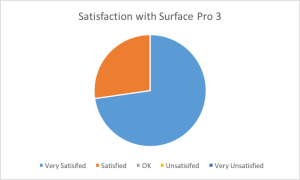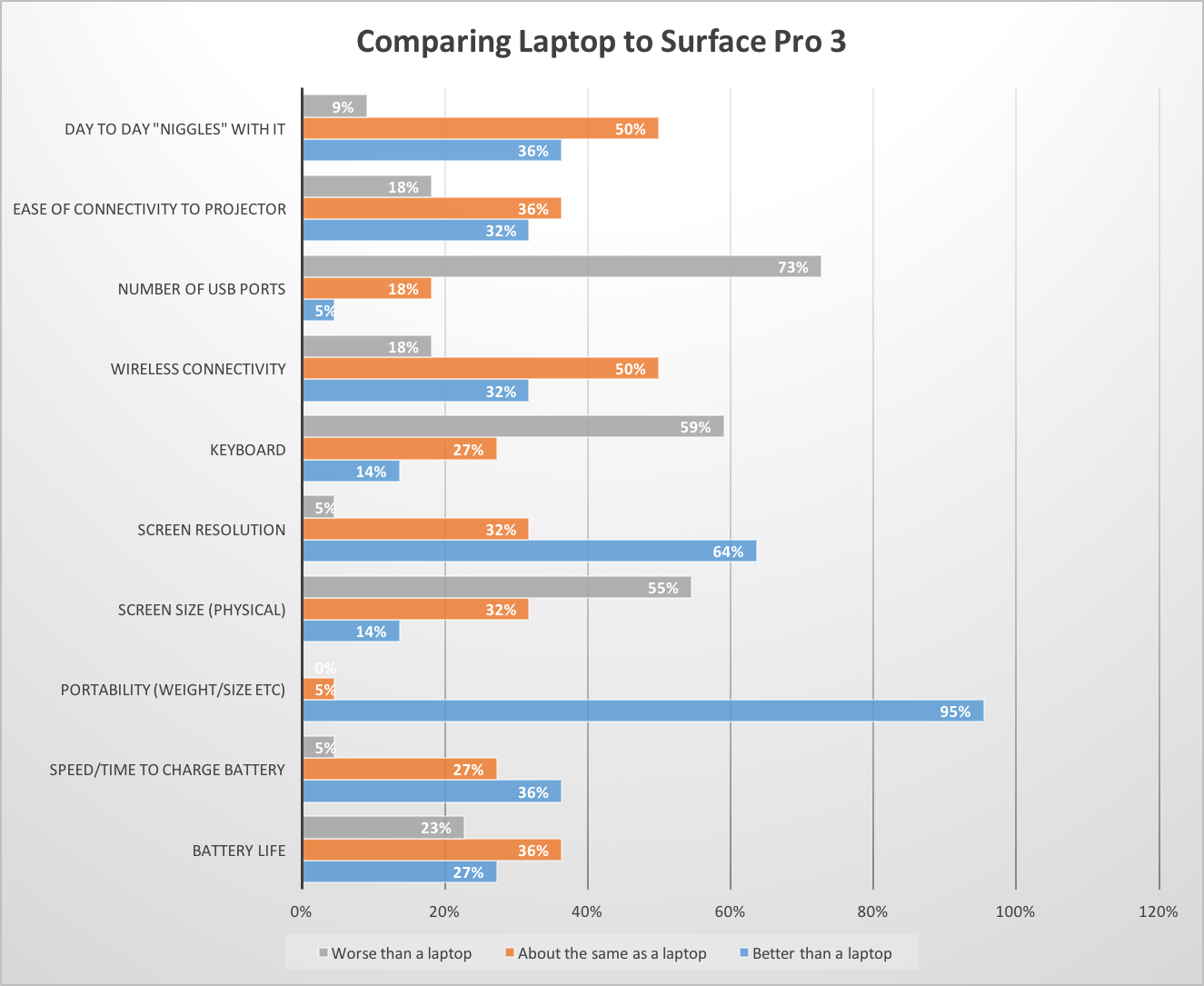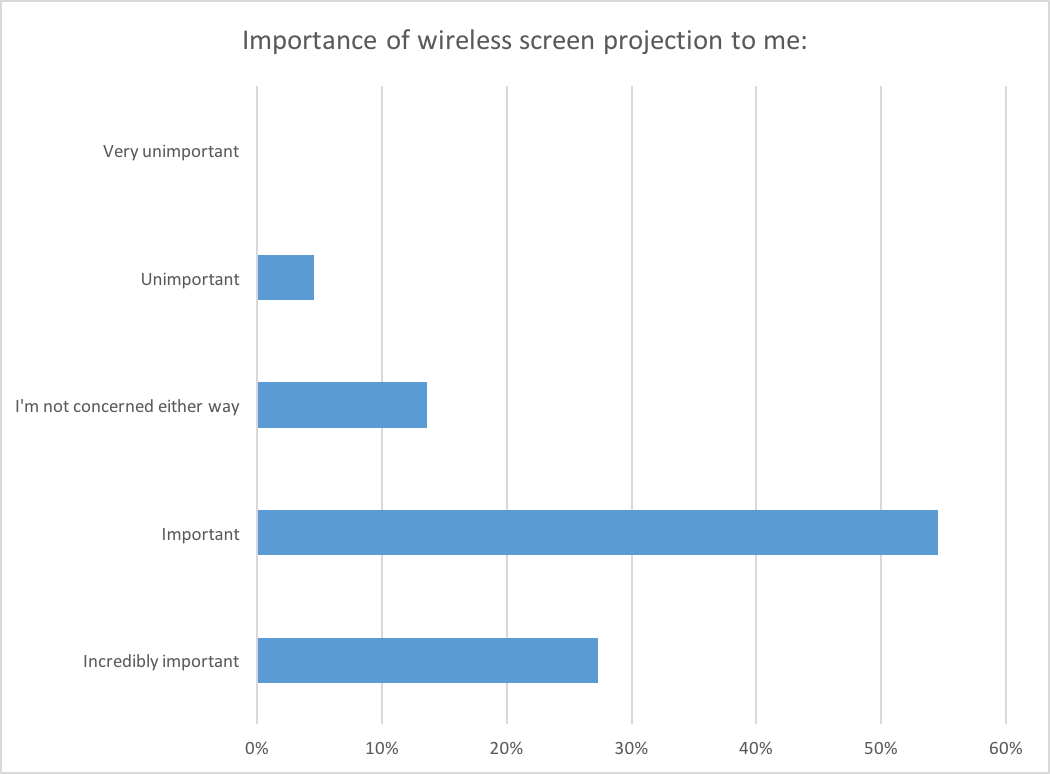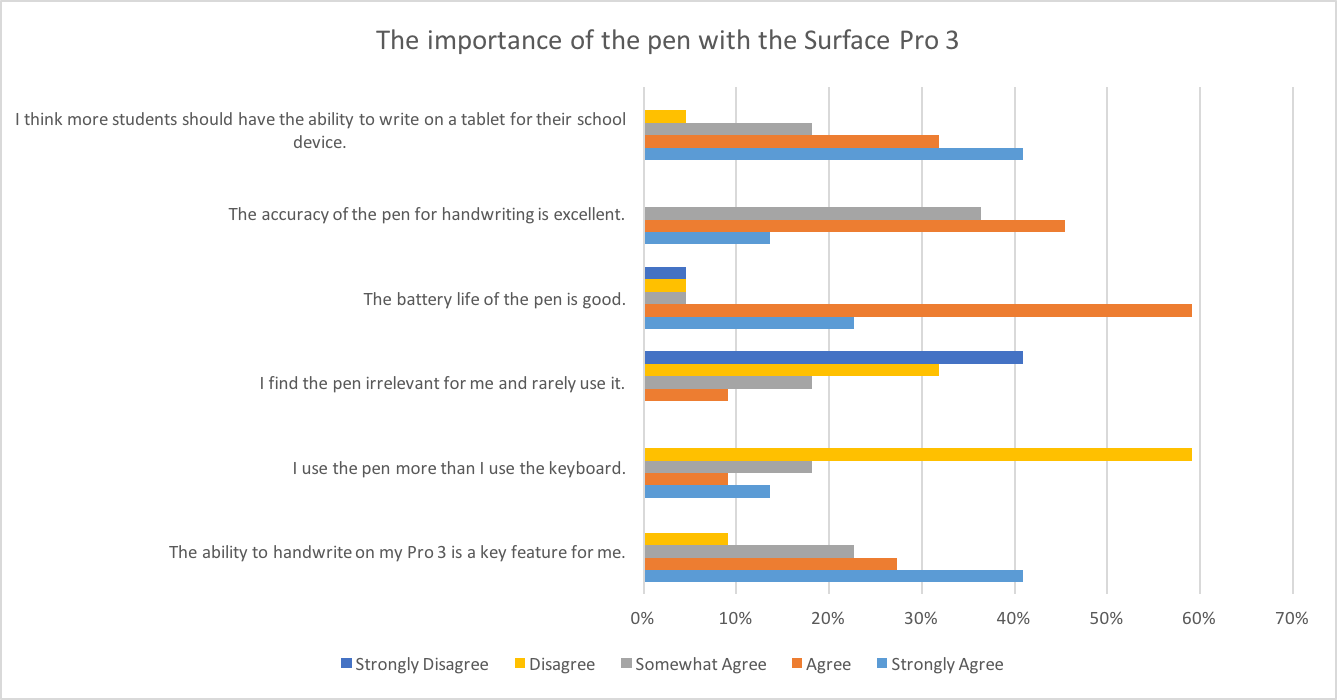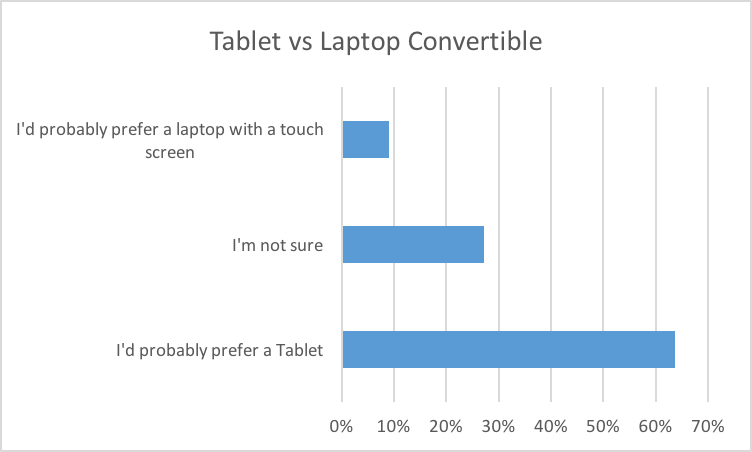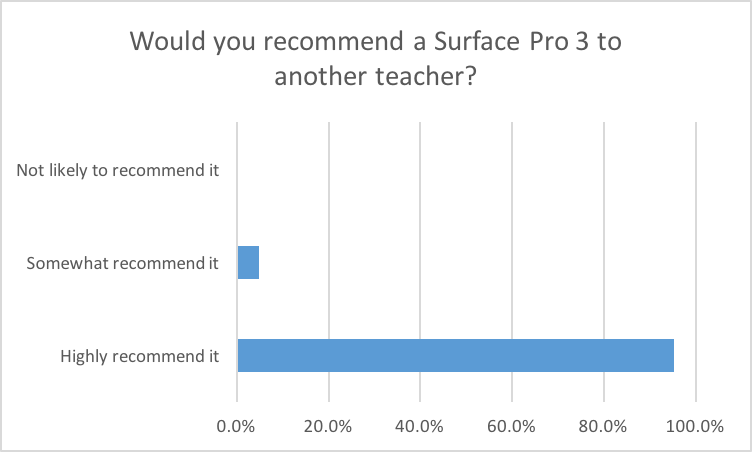Christchurch's St Andrew's College reflects on Surface Pro 3 use
This post has been re-blogged from Sam McNeill's StAC e-Learning Stories blog. Microsoft is excited to share this feedback on how the Surface Pro 3 has performed at St Andrew's College, and how it has simplified teaching and learning.
As we approach the first anniversary of the Surface Pro 3 release in New Zealand, I’ve been reflecting on the fact that we now have 26 staff members using them across the school. An earlier update on how how teachers have been using the Pro 3 in their classes remains one of the more popular posts on this blog and in anticipation of teacher demand for tablets in 2016, I have surveyed those staff members who use a Surface Pro 3.
The overall satisfaction rates of teachers with the Surface Pro 3 is very high
Using SurveyMonkey I have collated some interesting feedback from teachers and share it here for the benefit of other schools that may be interested in exploring the tablets for their teachers.
Whilst it is not always easy to ask the “right” questions when it comes to getting useful feedback I have tried to get staff to compare the key features and functionality of a Surface Pro 3 with a traditional laptop that the College has issued to teaching staff:
An interesting comment to the above responses from a teacher was:
"What is not mentioned above is the functionality – the Surface is far more functional than a laptop as it doubles as a tablet, when needed. This is the huge advantage of a Surface over a laptop."
It is important to acknowledge some of those “niggles” that teachers have experienced because no device is perfect. Here is some feedback from staff highlighting some of the challenges of the device:
"The keyboard needs to be taken off and reattached to remedy glitches. The keyboard is small and I often hit the caps button. Consider body posture when using the Surface Pro 3 so that you are not hunched. Before putting a plastic box on the desk and under the tablet, I would wonder why I had a sore neck/back/eyestrain."
"The thing I really don’t like is a cheapie-feeling keyboard and how I keen hitting two keys at once … lack of USB ports is really annoying too."
"Some issues with it freezing when in sleep mode. Need to force a restart when this happens."
We have done a significant amount of experimentation with wireless projection at St Andrew’s College and a future post will cover what we have settled on, however currently only 41% of our teachers with Surface Pro 3 tablets are using wireless projection (this number is skewed as well because the majority of our SP3 users are in our Preparatory School because of where their lease renewal occurred). However, 96% of the teachers said they would use wireless projection if it was available in their class, with the following breakdown showing how significant it is to their teaching style:
Clearly, the ability to roam a classroom “untethered” from the front and a data projector cable is a big drawcard for teachers and a trend I see only growing as the technology becomes more reliable.
One of the key features of the Surface Pro 3 is the great accuracy of the pen and the ability to “write” into OneNote very easily; a feature that is consistently praised by our teachers. This question specifically asked about the usefulness of the pen:
Some departments at St Andrew’s College would love to change the requirement for students that all devices must support “inking” in some format, and it’s easy to see why: subjects that involve diagrams, formula and equations would be significantly easier for students if they could simply handwrite directly into OneNote.
Whilst the Surface Pro 3 is experiencing favourable feedback from teachers, we are also looking at “convertible laptops” that allow for the handwriting on the screen such as the HP Spectre x360 that folds back into a tablet. Historically, our testing of units like this have been disappointing as the accuracy of the inking on these hybrids just could not compete with genuine tablets like the Pro 3. That said, the attraction of a proper keyboard and a larger screen appeals to some of our teachers:
Ultimately, the value of any device to a teacher can be measured in whether they would recommend it to their colleagues: on this point, the teachers were almost unanimous.
One interesting comment from a teacher in the Preparatory School reflects the uptake of tablets in their class by students, purely based on what they have seen from teachers using the devices:
"A number of staff in the Prep School who opted for laptops now regret their choice and given the opportunity would switch to a surface. 8 students in my class now use surface tablets – 2 having switched from Mac."
How has the practice of our teachers changed with the Surface Pro 3?
This is a difficult question to get answers to in some ways but a critical one to understand what, if any, impact on pedagogy a technology shift has had for our teachers. Up until the introduction of the Surface Pro 3 the teachers at St Andrew’s were all given identical laptops. By introducing some limited choice it has increased the support costs of maintenance and spares, therefore it was hoped there would be some positive changes or improvements in teaching practice. Here is a selection of some replies from teachers:
"My practice has not changed, but the mobility of the Surface and the fact that will do all I ask of it has adapted my style. I am able to work with the students annotating a piece of writing or work through maths problems using the stylus and each child is able to revisit this learning through OneNote. The mobility, wireless projector connectivity and stylus allow me to get away from the desk and be with the students when teaching. Most importantly – the students use of the Surface to share with others is powerful. They take my surface and use it to explain concepts to a group when linked to the projector and when used in conjunction with OneNote, students collaborate in real time on a piece of learning using their stylus on their own Surface tablets." - Maths Teacher
A reply from a Preparatory School teacher suggests it can lead to MORE work: "I probably end up doing more work from home as it is much more portable [than a laptop]".
"It has not changed my practice, but has complemented it very well. I already used my own Surface in conjunction with a school laptop. Before the Surface, I used my phone to do many of the same functions, complemented by a laptop. Having a Surface provided by school has meant operating fewer devices for the same outcomes, making it easier when you don’t have your own classroom." - Science Teacher
"More movement around the class, use of pen and writing has enhanced the annotation ability, marking and so forth, integration of technology, ease of OneNote and working 1 on 1 with students. light, easy to move around with especially when wirelessly not connected to data projector" - English Teacher
"I don’t write on whiteboard anymore – I write directly onto my OneNote page so students can access this" - Science Teacher
"Much easier to use in PE settings ie with pen and tablet. Therefore I am more likely to use it, and complete observation style tasks more frequently. Easier to mark / use OneNote – I can mark and make comments quickly using the pen" - PE Teacher
"Less time at my desk and more time with students. Ability to take teaching outside the classroom, faster and with more resources. Being able to show examples of preferred practices with ease and ability to document past/current teaching and interactions with the students has been key. Students are assisted by this to become more reflective learners. (ability to revisit work via OneNote)." - Preparatory School Teacher
A recurring theme comes through in these responses in terms of how a tablet, with the ability to ink, enhances the value of Microsoft OneNote, a key tool that is being used at our College.
The above information is important for the ICT team to understand. Like many schools, we lease our teacher laptops/devices and renew these every three years. The teaching staff leases are split into three, so each year we replace 1/3 of the devices (around 45-50), and I anticipate that the majority of our teachers who are up for a new device in 2016 will want something they can write on. The above information will be disseminated to those teachers to help them make informed decisions and also assist the ICT department in providing the best support possible.
